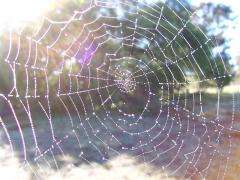February 8, 2010 feature
Physicists investigate structural properties of spider webs

(PhysOrg.com) -- "Although the orb web of a spider is a lightweight structure, it seems to be a highly optimized structure, presumably as a result of evolution from the Jurassic period or earlier," explain physicists Yuko Aoyananagi and Ko Okumura, who are investigating the structural properties of spider webs. "It seems to resist different loads such as wind and insect impact efficiently and can catch prey even if some threads are broken."
Although much research has been done on spider silk as a high-performance fiber, much less is known about the structural mechanical properties of webs. In a recent study, Aoyananagi and Okumura, both from Ochanomizu University in Tokyo, Japan, have developed a model that explains the mechanical adaptability of spider orb webs. As the most familiar web form, orb webs have features that are universal to many spider species, suggesting that they have beneficially evolved by natural selection. By better understanding the unique structural properties of spider webs, researchers could apply the information to other areas, such as designing buildings, bridges, and space structures.
As the researchers explain, orb webs consist of two kinds of threads: radial threads radiate out from the center of the web, while spiral threads connect the radial threads together to form the familiar circular pattern. Previous research has shown that the radial threads are significantly stronger than spiral threads, which is due to radial threads’ greater thickness, chemical composition and microscopic structure.
When completed by a spider, the entire spider web is under tension. In the physicists’ model, the force distribution is such that the threads with the maximum force are the radial threads located at the outmost parts of the web. The scientists also found that, for a typical web, spiders can change the number of radial or spiral threads without reducing the strength of the web. This versatility is likely very useful for spiders to adapt the web to various environments, such as in areas with few places on which to attach radial threads. Or, when a spider wishes to make the web denser to catch smaller insects, it can spin more spiral threads without significantly increasing the maximum force.
Aoyananagi and Okumura also investigated what happens when one of the spiral threads is damaged in an otherwise intact web. In most structures made of elastic materials, the force gets redistributed when damage occurs, and a stress concentration occurs near the damage, which weakens the overall structure. However, in a spider web, the force distribution remains unchanged when any spiral thread is broken, and the web retains its strength. The scientists attribute this damage tolerance to the web’s hierarchical design, which they hope to model in greater detail in the future.
More information: Yuko Aoyanagi and Ko Okumura. “Simple Model for the Mechanics of Spider Webs.” Physical Review Letters 104, 038102 (2010). DOI:10.1103/PhysRevLett.104.038102
Copyright 2010 PhysOrg.com.
All rights reserved. This material may not be published, broadcast, rewritten or redistributed in whole or part without the express written permission of PhysOrg.com.

















